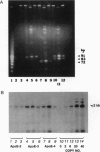Abstract
Transgenic mice carrying heterologous genes directed by a 670-bp segment of the regulatory sequence from the human transferrin (TF) gene demonstrated high expression in brain. Mice carrying the chimeric 0.67kbTF-CAT gene expressed TF-CAT in neurons and glial cells of the nucleus basalis, the cerebrum, corpus callosum, cerebellum, and hippocampus. In brains from two independent TF-CAT transgenic founder lines, copy number of TF-CAT mRNA exceeded the number of mRNA transcripts encoding either mouse endogenous transferrin or mouse endogenous amyloid precursor protein. In two transgenic founder lines, the chloramphenicol acetyltransferase (CAT) protein synthesized from the TF-CAT mRNA was estimated to be 0.10-0.15% of the total soluble proteins of the brain. High expression observed in brain indicates that the 0.67kbTF promoter is a promising director of brain expression of heterologous genes. Therefore, the promoter has been used to express the three common human apolipoprotein E (apoE) alleles in transgenic mouse brains. The apoE alleles have been implicated in the expression of Alzheimer disease, and the human apoE isoforms are reported to interact with different affinities to the brain beta-amyloid and tau protein in vitro. Results of this study demonstrate high expression and production of human apoE proteins in transgenic mouse brains. The model may be used to characterize the interaction of human apoE isoforms with other brain proteins and provide information helpful in designing therapeutic strategies for Alzheimer disease.
Full text
PDF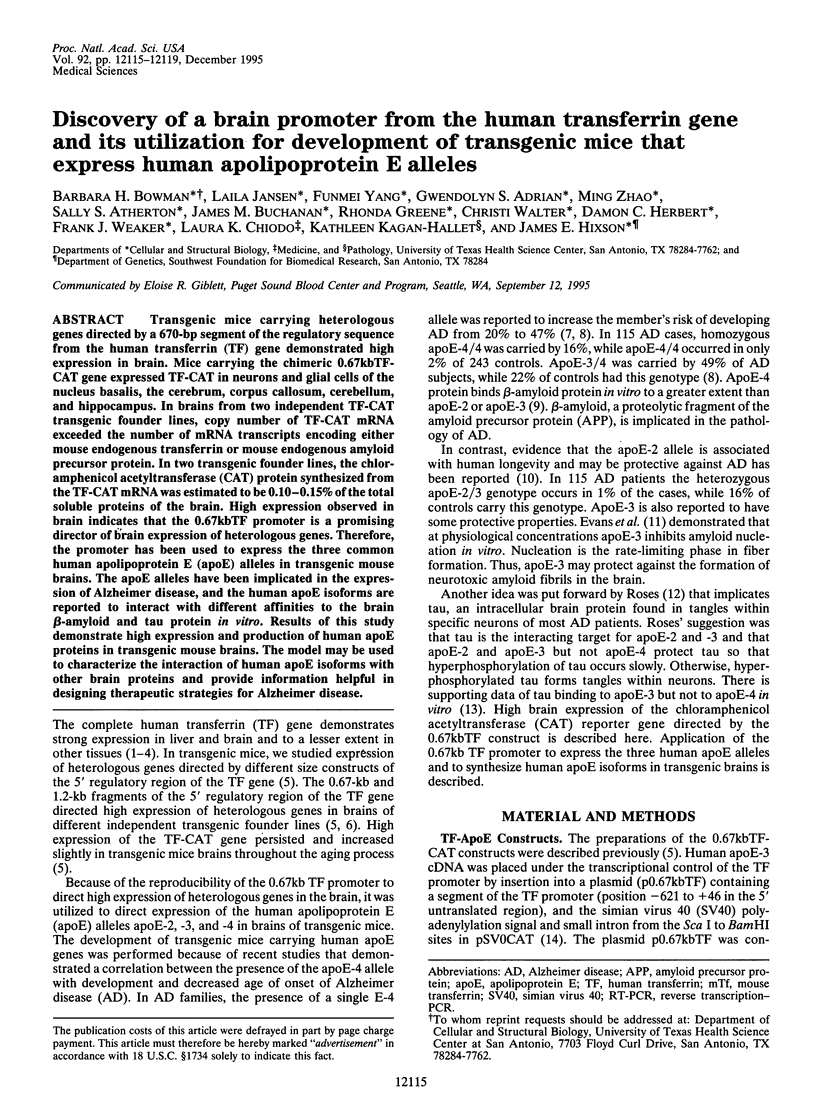
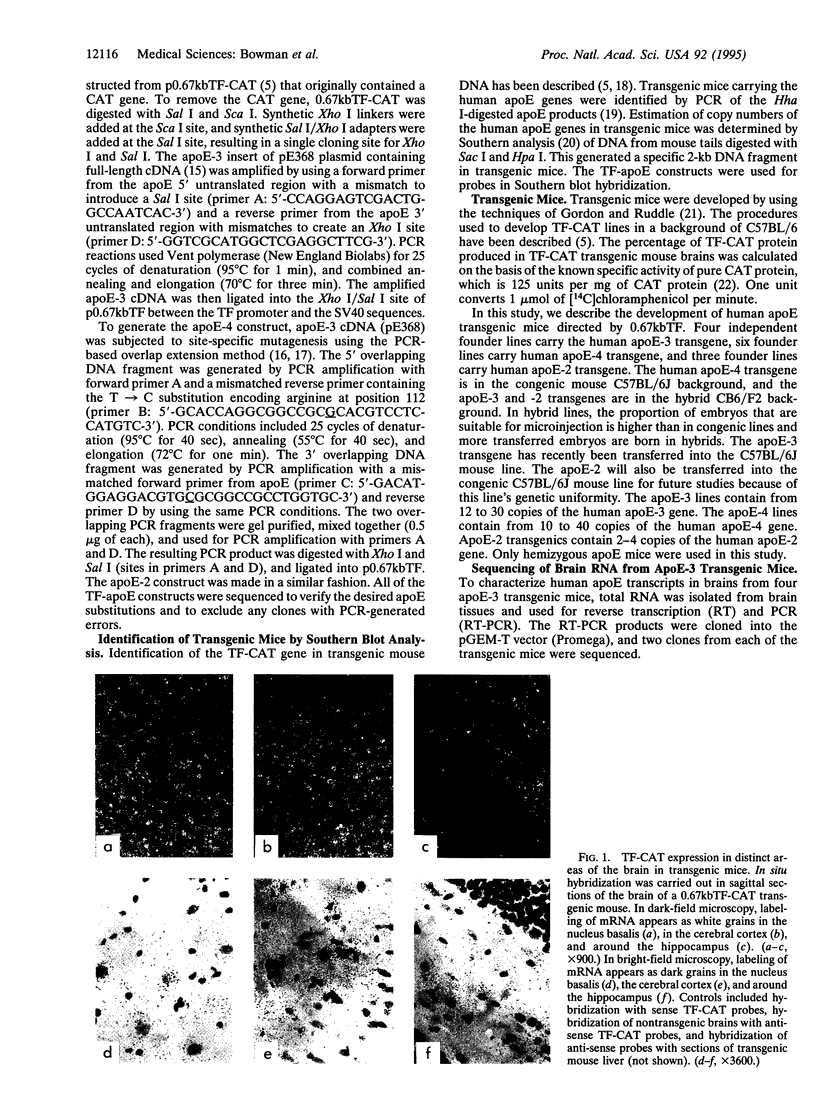
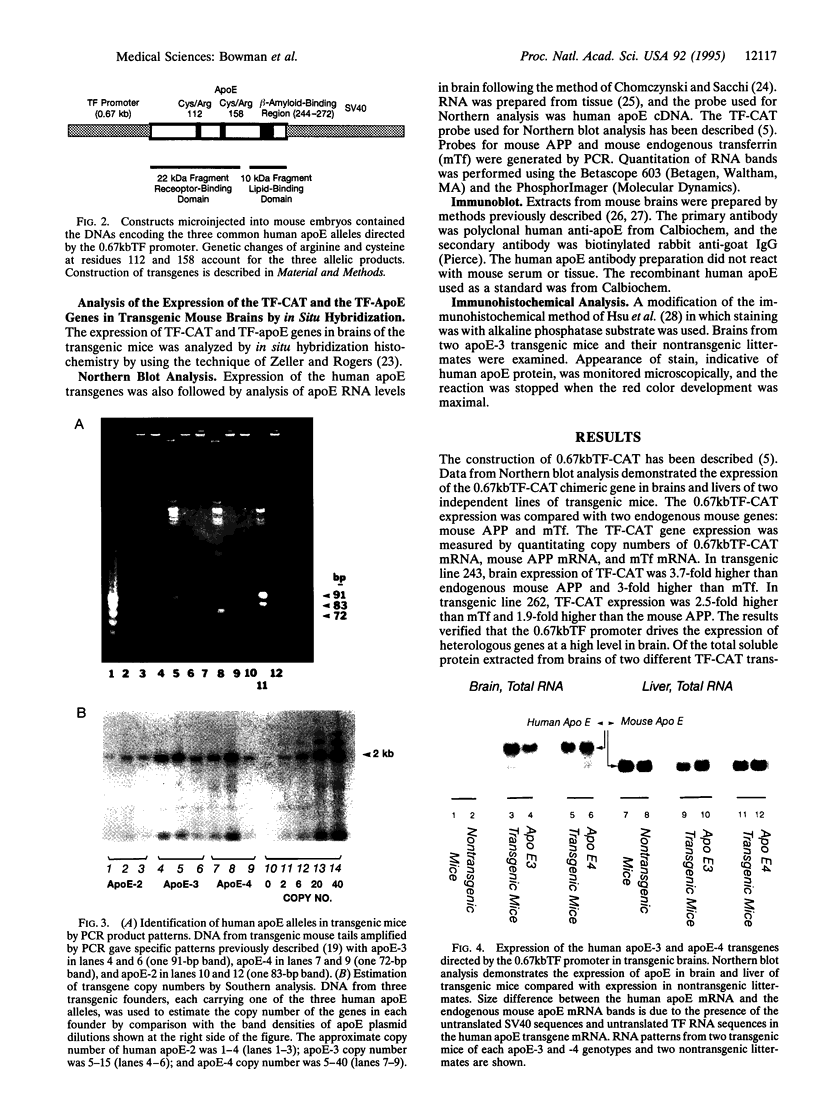
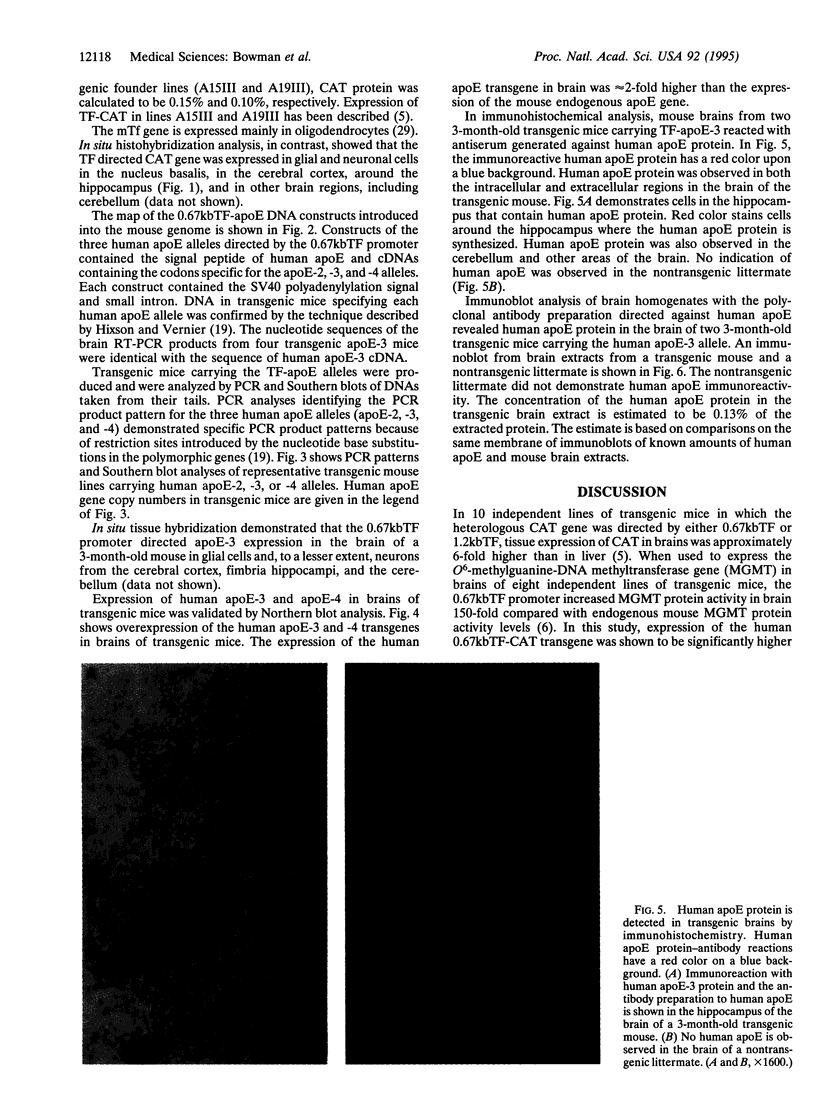
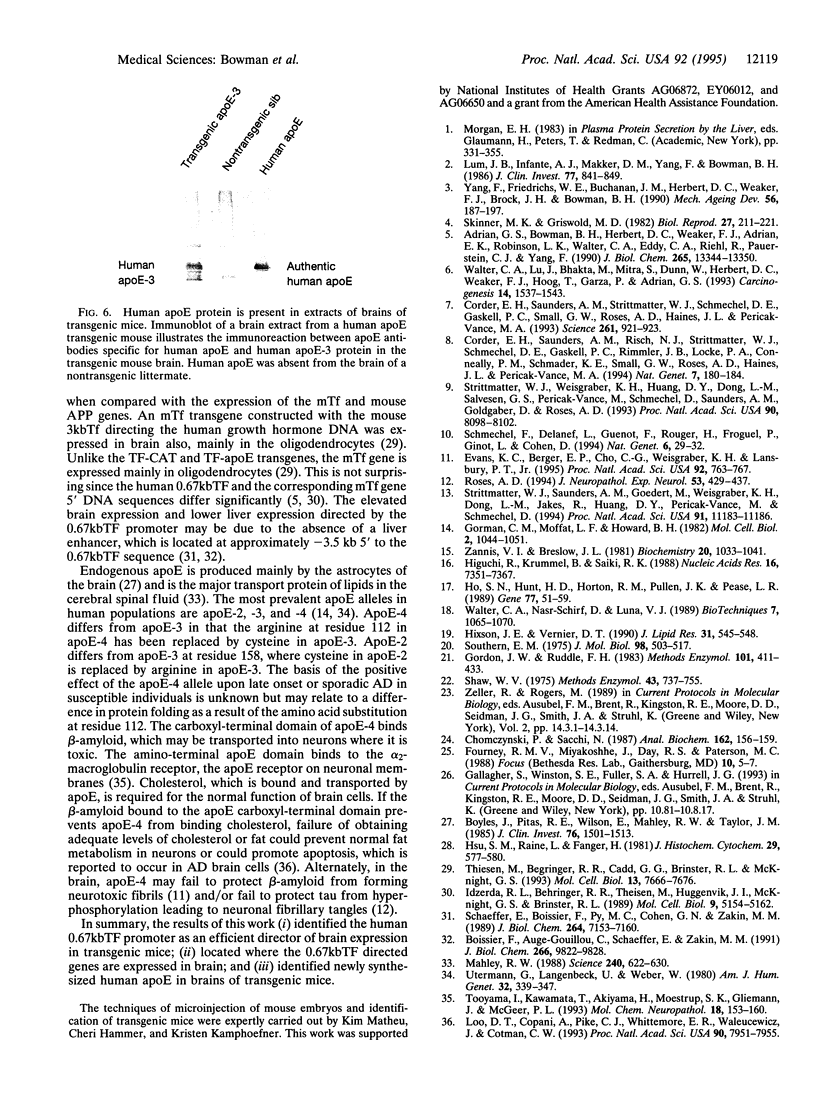
Images in this article
Selected References
These references are in PubMed. This may not be the complete list of references from this article.
- Adrian G. S., Bowman B. H., Herbert D. C., Weaker F. J., Adrian E. K., Robinson L. K., Walter C. A., Eddy C. A., Riehl R., Pauerstein C. J. Human transferrin. Expression and iron modulation of chimeric genes in transgenic mice. J Biol Chem. 1990 Aug 5;265(22):13344–13350. [PubMed] [Google Scholar]
- Boissier F., Augé-Gouillou C., Schaeffer E., Zakin M. M. The enhancer of the human transferrin gene is organized in two structural and functional domains. J Biol Chem. 1991 May 25;266(15):9822–9828. [PubMed] [Google Scholar]
- Boyles J. K., Pitas R. E., Wilson E., Mahley R. W., Taylor J. M. Apolipoprotein E associated with astrocytic glia of the central nervous system and with nonmyelinating glia of the peripheral nervous system. J Clin Invest. 1985 Oct;76(4):1501–1513. doi: 10.1172/JCI112130. [DOI] [PMC free article] [PubMed] [Google Scholar]
- Chomczynski P., Sacchi N. Single-step method of RNA isolation by acid guanidinium thiocyanate-phenol-chloroform extraction. Anal Biochem. 1987 Apr;162(1):156–159. doi: 10.1006/abio.1987.9999. [DOI] [PubMed] [Google Scholar]
- Corder E. H., Saunders A. M., Risch N. J., Strittmatter W. J., Schmechel D. E., Gaskell P. C., Jr, Rimmler J. B., Locke P. A., Conneally P. M., Schmader K. E. Protective effect of apolipoprotein E type 2 allele for late onset Alzheimer disease. Nat Genet. 1994 Jun;7(2):180–184. doi: 10.1038/ng0694-180. [DOI] [PubMed] [Google Scholar]
- Corder E. H., Saunders A. M., Strittmatter W. J., Schmechel D. E., Gaskell P. C., Small G. W., Roses A. D., Haines J. L., Pericak-Vance M. A. Gene dose of apolipoprotein E type 4 allele and the risk of Alzheimer's disease in late onset families. Science. 1993 Aug 13;261(5123):921–923. doi: 10.1126/science.8346443. [DOI] [PubMed] [Google Scholar]
- Evans K. C., Berger E. P., Cho C. G., Weisgraber K. H., Lansbury P. T., Jr Apolipoprotein E is a kinetic but not a thermodynamic inhibitor of amyloid formation: implications for the pathogenesis and treatment of Alzheimer disease. Proc Natl Acad Sci U S A. 1995 Jan 31;92(3):763–767. doi: 10.1073/pnas.92.3.763. [DOI] [PMC free article] [PubMed] [Google Scholar]
- Gordon J. W., Ruddle F. H. Gene transfer into mouse embryos: production of transgenic mice by pronuclear injection. Methods Enzymol. 1983;101:411–433. doi: 10.1016/0076-6879(83)01031-9. [DOI] [PubMed] [Google Scholar]
- Gorman C. M., Moffat L. F., Howard B. H. Recombinant genomes which express chloramphenicol acetyltransferase in mammalian cells. Mol Cell Biol. 1982 Sep;2(9):1044–1051. doi: 10.1128/mcb.2.9.1044. [DOI] [PMC free article] [PubMed] [Google Scholar]
- Higuchi R., Krummel B., Saiki R. K. A general method of in vitro preparation and specific mutagenesis of DNA fragments: study of protein and DNA interactions. Nucleic Acids Res. 1988 Aug 11;16(15):7351–7367. doi: 10.1093/nar/16.15.7351. [DOI] [PMC free article] [PubMed] [Google Scholar]
- Hixson J. E., Vernier D. T. Restriction isotyping of human apolipoprotein E by gene amplification and cleavage with HhaI. J Lipid Res. 1990 Mar;31(3):545–548. [PubMed] [Google Scholar]
- Ho S. N., Hunt H. D., Horton R. M., Pullen J. K., Pease L. R. Site-directed mutagenesis by overlap extension using the polymerase chain reaction. Gene. 1989 Apr 15;77(1):51–59. doi: 10.1016/0378-1119(89)90358-2. [DOI] [PubMed] [Google Scholar]
- Hsu S. M., Raine L., Fanger H. Use of avidin-biotin-peroxidase complex (ABC) in immunoperoxidase techniques: a comparison between ABC and unlabeled antibody (PAP) procedures. J Histochem Cytochem. 1981 Apr;29(4):577–580. doi: 10.1177/29.4.6166661. [DOI] [PubMed] [Google Scholar]
- Idzerda R. L., Behringer R. R., Theisen M., Huggenvik J. I., McKnight G. S., Brinster R. L. Expression from the transferrin gene promoter in transgenic mice. Mol Cell Biol. 1989 Nov;9(11):5154–5162. doi: 10.1128/mcb.9.11.5154. [DOI] [PMC free article] [PubMed] [Google Scholar]
- Loo D. T., Copani A., Pike C. J., Whittemore E. R., Walencewicz A. J., Cotman C. W. Apoptosis is induced by beta-amyloid in cultured central nervous system neurons. Proc Natl Acad Sci U S A. 1993 Sep 1;90(17):7951–7955. doi: 10.1073/pnas.90.17.7951. [DOI] [PMC free article] [PubMed] [Google Scholar]
- Lum J. B., Infante A. J., Makker D. M., Yang F., Bowman B. H. Transferrin synthesis by inducer T lymphocytes. J Clin Invest. 1986 Mar;77(3):841–849. doi: 10.1172/JCI112381. [DOI] [PMC free article] [PubMed] [Google Scholar]
- Mahley R. W. Apolipoprotein E: cholesterol transport protein with expanding role in cell biology. Science. 1988 Apr 29;240(4852):622–630. doi: 10.1126/science.3283935. [DOI] [PubMed] [Google Scholar]
- Roses A. D. Apolipoprotein E affects the rate of Alzheimer disease expression: beta-amyloid burden is a secondary consequence dependent on APOE genotype and duration of disease. J Neuropathol Exp Neurol. 1994 Sep;53(5):429–437. doi: 10.1097/00005072-199409000-00002. [DOI] [PubMed] [Google Scholar]
- Schaeffer E., Boissier F., Py M. C., Cohen G. N., Zakin M. M. Cell type-specific expression of the human transferrin gene. Role of promoter, negative, and enhancer elements. J Biol Chem. 1989 May 5;264(13):7153–7160. [PubMed] [Google Scholar]
- Schächter F., Faure-Delanef L., Guénot F., Rouger H., Froguel P., Lesueur-Ginot L., Cohen D. Genetic associations with human longevity at the APOE and ACE loci. Nat Genet. 1994 Jan;6(1):29–32. doi: 10.1038/ng0194-29. [DOI] [PubMed] [Google Scholar]
- Shaw W. V. Chloramphenicol acetyltransferase from chloramphenicol-resistant bacteria. Methods Enzymol. 1975;43:737–755. doi: 10.1016/0076-6879(75)43141-x. [DOI] [PubMed] [Google Scholar]
- Skinner M. K., Griswold M. D. Secretion of testicular transferrin by cultured Sertoli cells is regulated by hormones and retinoids. Biol Reprod. 1982 Aug;27(1):211–221. doi: 10.1095/biolreprod27.1.211. [DOI] [PubMed] [Google Scholar]
- Southern E. M. Detection of specific sequences among DNA fragments separated by gel electrophoresis. J Mol Biol. 1975 Nov 5;98(3):503–517. doi: 10.1016/s0022-2836(75)80083-0. [DOI] [PubMed] [Google Scholar]
- Strittmatter W. J., Saunders A. M., Goedert M., Weisgraber K. H., Dong L. M., Jakes R., Huang D. Y., Pericak-Vance M., Schmechel D., Roses A. D. Isoform-specific interactions of apolipoprotein E with microtubule-associated protein tau: implications for Alzheimer disease. Proc Natl Acad Sci U S A. 1994 Nov 8;91(23):11183–11186. doi: 10.1073/pnas.91.23.11183. [DOI] [PMC free article] [PubMed] [Google Scholar]
- Strittmatter W. J., Weisgraber K. H., Huang D. Y., Dong L. M., Salvesen G. S., Pericak-Vance M., Schmechel D., Saunders A. M., Goldgaber D., Roses A. D. Binding of human apolipoprotein E to synthetic amyloid beta peptide: isoform-specific effects and implications for late-onset Alzheimer disease. Proc Natl Acad Sci U S A. 1993 Sep 1;90(17):8098–8102. doi: 10.1073/pnas.90.17.8098. [DOI] [PMC free article] [PubMed] [Google Scholar]
- Theisen M., Behringer R. R., Cadd G. G., Brinster R. L., McKnight G. S. A C/EBP-binding site in the transferrin promoter is essential for expression in the liver but not the brain of transgenic mice. Mol Cell Biol. 1993 Dec;13(12):7666–7676. doi: 10.1128/mcb.13.12.7666. [DOI] [PMC free article] [PubMed] [Google Scholar]
- Tooyama I., Kawamata T., Akiyama H., Moestrup S. K., Gliemann J., McGeer P. L. Immunohistochemical study of alpha 2 macroglobulin receptor in Alzheimer and control postmortem human brain. Mol Chem Neuropathol. 1993 Jan-Feb;18(1-2):153–160. doi: 10.1007/BF03160029. [DOI] [PubMed] [Google Scholar]
- Utermann G., Langenbeck U., Beisiegel U., Weber W. Genetics of the apolipoprotein E system in man. Am J Hum Genet. 1980 May;32(3):339–347. [PMC free article] [PubMed] [Google Scholar]
- Walter C. A., Lu J., Bhakta M., Mitra S., Dunn W., Herbert D. C., Weaker F. J., Hoog T., Garza P., Adrian G. S. Brain and liver targeted overexpression of O6-methylguanine DNA methyltransferase in transgenic mice. Carcinogenesis. 1993 Aug;14(8):1537–1543. doi: 10.1093/carcin/14.8.1537. [DOI] [PubMed] [Google Scholar]
- Walter C. A., Nasr-Schirf D., Luna V. J. Identification of transgenic mice carrying the CAT gene with PCR amplification. Biotechniques. 1989 Nov-Dec;7(10):1065–1070. [PubMed] [Google Scholar]
- Yang F. M., Friedrichs W. E., Buchanan J. M., Herbert D. C., Weaker F. J., Brock J. H., Bowman B. H. Tissue specific expression of mouse transferrin during development and aging. Mech Ageing Dev. 1990 Nov;56(2):187–197. doi: 10.1016/0047-6374(90)90009-5. [DOI] [PubMed] [Google Scholar]
- Zannis V. I., Breslow J. L. Human very low density lipoprotein apolipoprotein E isoprotein polymorphism is explained by genetic variation and posttranslational modification. Biochemistry. 1981 Feb 17;20(4):1033–1041. doi: 10.1021/bi00507a059. [DOI] [PubMed] [Google Scholar]




